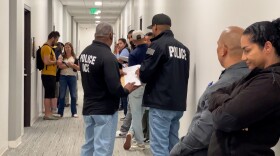![Mohammad Reza Mahdian, holding his year-old daughter, brought his family to visit Persepolis. The site is a reminder, he says, that "nothing will remain but [rulers'] good works."](https://cdn.kpbs.org/dims4/default/040e805/2147483647/strip/true/crop/3997x2462+0+268/resize/880x542!/quality/90/?url=http%3A%2F%2Fkpbs-brightspot.s3.us-west-2.amazonaws.com%2Fassets%2Fimg%2F2016%2F02%2F18%2Fpersepolis---mohammed-reza-mahdian-shia-cleric-with-his-one-year-old-daughter-2-edit-6fc6998fec3ae7300b17627a04c80687c1bbb1ae.jpg)


Why would Iranians visit their country's most spectacular ancient sites and come away disappointed?
We talked with 10 Iranian visitors to Persepolis, the ruins of an ancient Persian capital, and found a collective sense of unease — less with the ruins themselves than with what they imply about the world around them.
Consider a young woman who took a selfie amid the stones. "This is so beautiful," she said as she stood near 2,500-year-old limestone columns. She'd come with her husband on vacation and had dressed up for the occasion in a gold-colored coat, designer scarf and sunglasses. She loved Persepolis.
But then her tone shifted.
"Everything we have belongs to a long time ago," she said. "We have nothing new that makes us special in the world."
That was a common sentiment at this spectacular site, to which Iran wants to attract more foreign tourists now that a nuclear deal has created the possibility of greater openness.
What attracted us was the chance to meet Iranian visitors, of whom there were many. On this sunny morning, a student group wandered past a sculpture of a two-headed griffin, each head distinguished by its birdlike beak. Soldiers in uniform toured the ruins. It's commonly part of their training to be reminded of ancient times when Persia was the center of a powerful empire.
Mohammad Reza Mahdian brought his family to the ruins. He wore the brown robes and white turban of a Shiite Muslim cleric. Holding his 1-year-old daughter as he spoke, the cleric said the ruins are a good reminder: "All kings and rulers will die someday," he said. "Nothing will remain of them but their good works."
The ruins prompted other visitors to ponder the leaders of today. We repeatedly heard people express this sense that life must have been better 2,500 years ago.
"I think that time was better than now," said one man as he studied the ruins.
Surely he was wrong. Surely life was short and brutal back then, unless you were actually king. But what he saw was the residual grandeur of another age. He compared it with the country where he lives today, with its sagging economy and still-limited freedom of dissent.
In fact, we're not naming this man, or several other people we met, since they clearly became uneasy that they had said too much.
The man was not actually inside the ruined city itself. One must pay to walk inside. Instead he had come with his wife and toddler to sit on a blanket near the entrance. They do this a lot, eating a snack and studying the ancient stone.
"I think people had more freedom than now. This [is a] sort of dictatorship," he said. "We used to be more connected with the world."
He said he was educated as an engineer but was stuck in a menial job in a food processing plant.
His wife, wearing a bright green headscarf that billowed in the breeze, listened to all of this while tending to their toddler. She said she also had a college education.
"My major is electrical [engineering]," she said. "But no jobs. I'm forced to be a housewife."
The husband had a long-term plan to get out.
"If I work in that factory for 10 more years, I'll have the money to move my family to Canada," he said. "I like the cold," he added.
"I want to become a Canadian citizen," he said, "not some refugee." He's giving himself 10 years to earn enough money. "Whatever the situation will be, when you spend money it will be solved," he said. "I'm going to take huge money with me to feel comfortable."
His wife, listening to him, said she'd rather stay in Iran with her family. But for now, the husband said, leaving is their plan.
For him, the past is here in Iran. The future lies somewhere else.
Copyright 2016 NPR. To see more, visit http://www.npr.org/.






